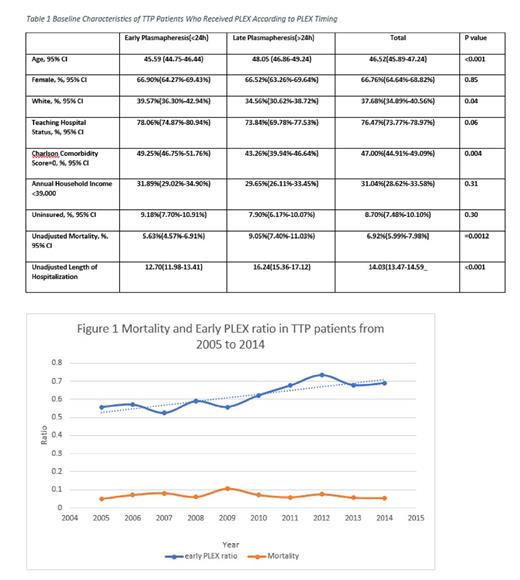Abstract
Background: Thrombocytopenic Thrombotic Purpura (TTP) carries profound morbidity and mortality despite nationwide availability of plasmapheresis (PLEX) (Benhamou et al Haematologica 2012). Since PLEX is crucial for TTP care, we aim to explore if early PLEX (within 24 hours of admission) is associated with decreased in-hospital mortality, decreased length of hospitalization and decreased hospitalization cost.
Method: The Nationwide Inpatient Sample (NIS) is a validated database of discharges from a representative sampling of U.S. hospitals that excludes rehab facilities and federal hospitals. Using the NIS, we identified adult patients hospitalized with ICD-9 codes for TTP and PLEX from 2005 to 2014. A subset of patients who received ICU level of care was also identified. Inflation-adjusted total hospitalization costs were calculated using Total Hospital Charge (TOTCHG), Consumer Price Index (CPI) and Cost-to-Charge Ratio (CCR). Both total hospitalization cost and length of hospitalization were normalized using log transformation. Trend analysis of TTP mortality and early PLEX rate were performed. We used logistic regression to determine timing of PLEX to in-hospital mortality as well as timing of PLEX to usage of ICU care among patients with TTP, adjusting for year of admission, demographics (gender, race, age), socioeconomic variables (income, insurance), geography (facility location), institution type (facility ownership, teaching hospital status), and comorbidity (Charlson comorbid score). Associations between ICU-level of care and early PLEX were also assessed by using logistic regression adjusted for the same factors as above. We used multivariate regression to determine associations between timing of PLEX and costs adjusted for the same variables plus inflation rate, and length of hospitalization. Finally, we assessed for associations between timing of PLEX and length of hospitalization using multivariate regression adjusted for same variables used for timing of PLEX to cost associations excluding length of hospitalization.
Results: We identified 2713 patients with diagnosis of TTP in the NIS database who received inpatient plasmapheresis from 2005 to 2014, equivalent to an estimated 13072 nationwide admissions. Out of these, 62.33% of the estimated admissions received plasmapheresis within 24 hours. At baseline, patients in the early PLEX group were more likely to be younger and Caucasian. They also had fewer comorbidities and experience shorter hospital stays. Unadjusted mortality was lower in the early PLEX group. No differences in gender, teaching hospital status, insurance status or household income were observed (Table 1). Trend analysis showed increased rate of early PLEX use (p<0.001) but no significant difference in mortality (p=0.22) in TTP patients over the study period (Figure 1). Logistic regression analysis showed that early PLEX was associated with decreased usage of ICU level of care (p=0.009). However, in this analysis, early PLEX did not predict decreased mortality (p=0.08). Multivariate regression analysis revealed that early PLEX was correlated with decreased length of hospitalization and decreased total hospitalization cost.
Conclusion: From 2005 to 2014, in-hospital mortality outcome of TTP did not improve despite increased early PLEX usage. Early PLEX usage is associated with decreased length of hospitalization and decreased hospitalization cost even when corrected for length of hospitalization. This may be due to decreased usage of ICU level of care. Further cost-effectiveness analysis needs to be performed to determine areas of healthcare resource utilization where savings could be obtained by treating TTP patients with early PLEX.
No relevant conflicts of interest to declare.
Author notes
Asterisk with author names denotes non-ASH members.


